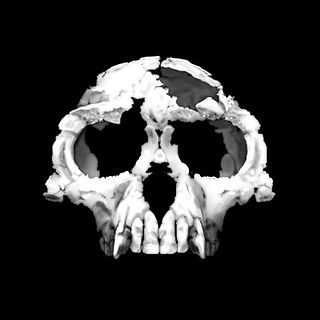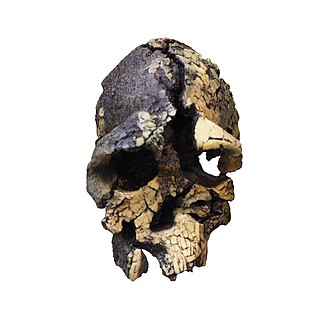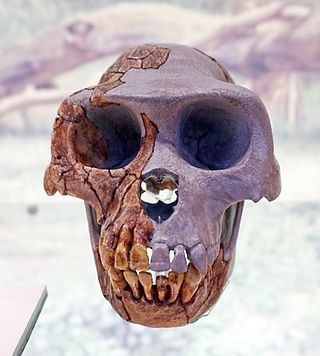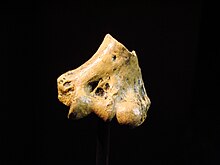
Ardipithecus is a genus of an extinct hominine that lived during the Late Miocene and Early Pliocene epochs in the Afar Depression, Ethiopia. Originally described as one of the earliest ancestors of humans after they diverged from the chimpanzees, the relation of this genus to human ancestors and whether it is a hominin is now a matter of debate. Two fossil species are described in the literature: A. ramidus, which lived about 4.4 million years ago during the early Pliocene, and A. kadabba, dated to approximately 5.6 million years ago. Initial behavioral analysis indicated that Ardipithecus could be very similar to chimpanzees, however more recent analysis based on canine size and lack of canine sexual dimorphism indicates that Ardipithecus was characterised by reduced aggression, and that they more closely resemble bonobos.

Homininae, also called "African hominids" or "African apes", is a subfamily of Hominidae. It includes two tribes, with their extant as well as extinct species: 1) the tribe Hominini ―and 2) the tribe Gorillini (gorillas). Alternatively, the genus Pan is sometimes considered to belong to its own third tribe, Panini. Homininae comprises all hominids that arose after orangutans split from the line of great apes. The Homininae cladogram has three main branches, which lead to gorillas, and to humans and chimpanzees via the tribe Hominini and subtribes Hominina and Panina. There are two living species of Panina and two living species of gorillas, but only one extant human species. Traces of extinct Homo species, including Homo floresiensis have been found with dates as recent as 40,000 years ago. Organisms in this subfamily are described as hominine or hominines.

Kenyanthropus is a hominin genus identified from the Lomekwi site by Lake Turkana, Kenya, dated to 3.3 to 3.2 million years ago during the Middle Pliocene. It contains one species, K. platyops, but may also include the 2 million year old Homo rudolfensis, or K. rudolfensis. Before its naming in 2001, Australopithecus afarensis was widely regarded as the only australopithecine to exist during the Middle Pliocene, but Kenyanthropus evinces a greater diversity than once acknowledged. Kenyanthropus is most recognisable by an unusually flat face and small teeth for such an early hominin, with values on the extremes or beyond the range of variation for australopithecines in regard to these features. Multiple australopithecine species may have coexisted by foraging for different food items, which may be reason why these apes anatomically differ in features related to chewing.

Australopithecus is a genus of early hominins that existed in Africa during the Pliocene and Early Pleistocene. The genera Homo, Paranthropus, and Kenyanthropus evolved from some Australopithecus species. Australopithecus is a member of the subtribe Australopithecina, which sometimes also includes Ardipithecus, though the term "australopithecine" is sometimes used to refer only to members of Australopithecus. Species include A. garhi, A. africanus, A. sediba, A. afarensis, A. anamensis, A. bahrelghazali and A. deyiremeda. Debate exists as to whether some Australopithecus species should be reclassified into new genera, or if Paranthropus and Kenyanthropus are synonymous with Australopithecus, in part because of the taxonomic inconsistency.

Australopithecus afarensis is an extinct species of australopithecine which lived from about 3.9–2.9 million years ago (mya) in the Pliocene of East Africa. The first fossils were discovered in the 1930s, but major fossil finds would not take place until the 1970s. From 1972 to 1977, the International Afar Research Expedition—led by anthropologists Maurice Taieb, Donald Johanson and Yves Coppens—unearthed several hundreds of hominin specimens in Hadar, Ethiopia, the most significant being the exceedingly well-preserved skeleton AL 288-1 ("Lucy") and the site AL 333. Beginning in 1974, Mary Leakey led an expedition into Laetoli, Tanzania, and notably recovered fossil trackways. In 1978, the species was first described, but this was followed by arguments for splitting the wealth of specimens into different species given the wide range of variation which had been attributed to sexual dimorphism. A. afarensis probably descended from A. anamensis and is hypothesised to have given rise to Homo, though the latter is debated.
Paleoanthropology or paleo-anthropology is a branch of paleontology and anthropology which seeks to understand the early development of anatomically modern humans, a process known as hominization, through the reconstruction of evolutionary kinship lines within the family Hominidae, working from biological evidence and cultural evidence.

Paranthropus aethiopicus is an extinct species of robust australopithecine from the Late Pliocene to Early Pleistocene of East Africa about 2.7–2.3 million years ago. However, it is much debated whether or not Paranthropus is an invalid grouping and is synonymous with Australopithecus, so the species is also often classified as Australopithecus aethiopicus. Whatever the case, it is considered to have been the ancestor of the much more robust P. boisei. It is debated if P. aethiopicus should be subsumed under P. boisei, and the terms P. boisei sensu lato and P. boisei sensu stricto can be used to respectively include and exclude P. aethiopicus from P. boisei.

Australopithecus garhi is a species of australopithecine from the Bouri Formation in the Afar Region of Ethiopia 2.6–2.5 million years ago (mya) during the Early Pleistocene. The first remains were described in 1999 based on several skeletal elements uncovered in the three years preceding. A. garhi was originally considered to have been a direct ancestor to Homo and the human line, but is now thought to have been an offshoot. Like other australopithecines, A. garhi had a brain volume of 450 cc (27 cu in); a jaw which jutted out (prognathism); relatively large molars and premolars; adaptations for both walking on two legs (bipedalism) and grasping while climbing (arboreality); and it is possible that, though unclear if, males were larger than females. One individual, presumed female based on size, may have been 140 cm tall.

Koobi Fora refers primarily to a region around Koobi Fora Ridge, located on the eastern shore of Lake Turkana in the territory of the nomadic Gabbra people. According to the National Museums of Kenya, the name comes from the Gabbra language:
In the language of the Gabbra people who live near the site, the term Koobi Fora means a place of the commiphora and the source of myrrh...

Tim D. White is an American paleoanthropologist and Professor of Integrative Biology at the University of California, Berkeley. He is best known for leading the team which discovered Ardi, the type specimen of Ardipithecus ramidus, a 4.4 million-year-old likely human ancestor. Prior to that discovery, his early career was notable for his work on Lucy as Australopithecus afarensis with discoverer Donald Johanson.

The Middle Awash is a paleoanthropological research area in the northwest corner of Gabi Rasu in the Afar Region along the Awash River in Ethiopia's Afar Depression. It is a unique natural laboratory for the study of human origins and evolution and a number of fossils of the earliest hominins, particularly of the Australopithecines, as well as some of the oldest known Olduwan stone artifacts, have been found at the site—all of late Miocene, the Pliocene, and the very early Pleistocene times, that is, about 5.6 million years ago (mya) to 2.5 mya. It is broadly thought that the divergence of the lines of the earliest humans (hominins) and of chimpanzees (hominids) was completed near the beginning of that time range, or sometime between seven and five mya. However, the larger community of scientists provide several estimates for periods of divergence that imply a greater range for this event, see CHLCA: human-chimpanzee split.

Yohannes Haile-SelassieAmbaye is an Ethiopian paleoanthropologist. An authority on pre-Homo sapiens hominids, he particularly focuses his attention on the East African Rift and Middle Awash valleys. He was curator of Physical Anthropology at the Cleveland Museum of Natural History from 2002 until 2021, and now is serving as the director of the Arizona State University Institute of Human Origins. Since founding the institute in 1981, he has been the third director after Donald Johanson and William Kimbel.

Ardipithecus kadabba is the scientific classification given to fossil remains "known only from teeth and bits and pieces of skeletal bones", originally estimated to be 5.8 to 5.2 million years old, and later revised to 5.77 to 5.54 million years old. According to the first description, these fossils are close to the common ancestor of chimps and humans. Their development lines are estimated to have parted 6.5–5.5 million years ago. It has been described as a "probable chronospecies" of A. ramidus. Although originally considered a subspecies of A. ramidus, in 2004 anthropologists Yohannes Haile-Selassie, Gen Suwa, and Tim D. White published an article elevating A. kadabba to species level on the basis of newly discovered teeth from Ethiopia. These teeth show "primitive morphology and wear pattern" which demonstrate that A. kadabba is a distinct species from A. ramidus.

Ardipithecus ramidus is a species of australopithecine from the Afar region of Early Pliocene Ethiopia 4.4 million years ago (mya). A. ramidus, unlike modern hominids, has adaptations for both walking on two legs (bipedality) and life in the trees (arboreality). However, it would not have been as efficient at bipedality as humans, nor at arboreality as non-human great apes. Its discovery, along with Miocene apes, has reworked academic understanding of the chimpanzee–human last common ancestor from appearing much like modern-day chimpanzees, orangutans and gorillas to being a creature without a modern anatomical cognate.
Ardi (ARA-VP-6/500) is the designation of the fossilized skeletal remains of an Ardipithecus ramidus, thought to be an early human-like female anthropoid 4.4 million years old. It is the most complete early hominid specimen, with most of the skull, teeth, pelvis, hands and feet, more complete than the previously known Australopithecus afarensis specimen called "Lucy." In all, 125 different pieces of fossilized bone were found.
Australopithecus deyiremeda is an extinct species of australopithecine from Woranso–Mille, Afar Region, Ethiopia, about 3.5 to 3.3 million years ago during the Pliocene. Because it is known only from three partial jawbones, it is unclear if these specimens indeed represent a unique species or belong to the much better-known A. afarensis. A. deyiremeda is distinguished by its forward-facing cheek bones and small cheek teeth compared to those of other early hominins. It is unclear if a partial foot specimen exhibiting a dextrous big toe can be assigned to A. deyiremeda. A. deyiremeda lived in a mosaic environment featuring both open grasslands and lake- or riverside forests, and anthropologist Fred Spoor suggests it may have been involved in the Kenyan Lomekwi stone-tool industry typically assigned to Kenyanthropus. A. deyiremeda coexisted with A. afarensis, and they may have exhibited niche partitioning to avoid competing with each other for the same resources, such as by relying on different fallback foods during leaner times.

Kanapoi is a paleontological site in the Kenyan Rift Valley, to the southwest of Lake Turkana. Fossils were first found at Kanapoi in the 1960s by a Harvard expedition, and later by expeditions from the National Museums of Kenya.
The savannah hypothesis is a hypothesis that human bipedalism evolved as a direct result of human ancestors' transition from an arboreal lifestyle to one on the savannas. According to the hypothesis, hominins left the woodlands that had previously been their natural habitat millions of years ago and adapted to their new habitat by walking upright.

The Allia Bay is a region on the east side of Lake Turkana in Kenya. The site is known for yielding its first hominid fossils in 1982, with further findings to this day, all of which have been identified as part of Australopithecus anamensis but possibly related to Australopithecus afarensis. Notable people with findings at Allia Bay include: Richard Leakey, Meave Leakey, Craig Feibel, Ian McDougall, Alan Walker.
The Middle Awash Project is an international research expedition conducted in the Afar region of Ethiopia with the goal of determining the origins of humanity. The project has the approval of the Ethiopian Culture Ministry and a strong commitment to developing Ethiopian archaeology, paleontology and geology research infrastructure. This project has discovered over 260 fossil specimens and over 17,000 vertebrate fossil specimens to date ranging from 200,000 to 6,000,000 years in age. Researchers have discovered the remains of four hominin species, the earliest subspecies of homo sapiens as well as stone tools. All specimens are permanently held at the National Museum of Ethiopia, where the project’s laboratory work is conducted year round.
















